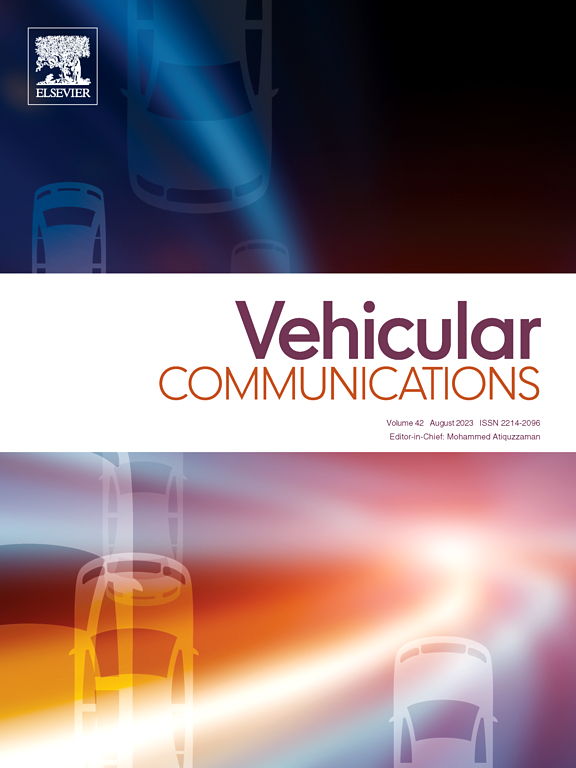BFP-Net: A DL-based ISAC beamforming prediction method for extended vehicle
IF 6.5
2区 计算机科学
Q1 TELECOMMUNICATIONS
引用次数: 0
Abstract
To enable the next generation of connected autonomous vehicles, the millimeter wave (mmWave)-based integrated sensing and communication (ISAC) system will be a critical technology in future vehicle-to-everything (V2X) networks. However, the rapid mobility of vehicles and the narrow beamwidth of mmWave signals present significant challenges for beam alignment, and point-target modeling methods often lead to substantial overhead, high latency, and complications. To address these issues, in this paper, a hybrid analog-digital (HAD) multi-input multi-output (MIMO) ISAC framework is adopted for the mmWave-based V2X network to reduce hardware costs and power consumption. Then, considering the narrow beamwidth of the mmWave system, the vehicle is modeled as an extended surface target with multiple scattering points, and a new association technique for these points is developed to improve prediction accuracy. Hence, a deep learning (DL)-based beamforming prediction network, namely beamforming prediction network (BFP-Net), is designed according to the ISAC signal beam prediction protocol and enables roadside units (RSUs) to transmit ISAC signals effectively for both downlink communication and sensing operations. The BFP-Net leverages a convolutional neural network long-short-term memory (CNN-LSTM) architecture to capture spatial and temporal correlations, providing enhanced modeling capabilities for beam prediction. Moreover, for highly dynamic vehicles, the BFP-Net predicts optimal beams for future time slots by extracting features from the received echo signals and eliminates the repetitive beam training inherent in the traditional communication protocol. Simulation results demonstrate that the proposed method significantly outperforms extended Kalman filter (EKF)-based methods in the mmWave V2X scenario, achieving higher beam gains and better performance for high-speed vehicles, and substantially reduces the overhead associated with beam training compared to the conventional neural network relying on pilot signals.
bp - net:一种基于dl的扩展车辆ISAC波束形成预测方法
为了实现下一代互联自动驾驶汽车,基于毫米波(mmWave)的集成传感和通信(ISAC)系统将成为未来车联网(V2X)网络的关键技术。然而,车辆的快速移动性和毫米波信号的窄波束宽度对波束对准提出了重大挑战,点目标建模方法通常会导致大量开销、高延迟和复杂性。为了解决这些问题,本文在基于毫米波的V2X网络中采用了混合模数(HAD)多输入多输出(MIMO) ISAC框架,以降低硬件成本和功耗。然后,考虑到毫米波系统的窄波束宽度,将车辆建模为具有多个散射点的扩展表面目标,并开发了一种新的散射点关联技术来提高预测精度。因此,根据ISAC信号波束预测协议设计了一种基于深度学习的波束形成预测网络,即波束形成预测网络(bbp - net),使路边单元(rsu)能够有效地传输ISAC信号进行下行通信和传感操作。bp - net利用卷积神经网络长短期记忆(CNN-LSTM)架构来捕获空间和时间相关性,为波束预测提供增强的建模能力。此外,对于高度动态的车辆,bp - net通过从接收到的回波信号中提取特征来预测未来时隙的最佳波束,并消除了传统通信协议中固有的重复波束训练。仿真结果表明,该方法在毫米波V2X场景中显著优于基于扩展卡尔曼滤波(EKF)的方法,在高速车辆中获得更高的波束增益和更好的性能,并且与依赖导频信号的传统神经网络相比,大大降低了波束训练相关的开销。
本文章由计算机程序翻译,如有差异,请以英文原文为准。
求助全文
约1分钟内获得全文
求助全文
来源期刊

Vehicular Communications
Engineering-Electrical and Electronic Engineering
CiteScore
12.70
自引率
10.40%
发文量
88
审稿时长
62 days
期刊介绍:
Vehicular communications is a growing area of communications between vehicles and including roadside communication infrastructure. Advances in wireless communications are making possible sharing of information through real time communications between vehicles and infrastructure. This has led to applications to increase safety of vehicles and communication between passengers and the Internet. Standardization efforts on vehicular communication are also underway to make vehicular transportation safer, greener and easier.
The aim of the journal is to publish high quality peer–reviewed papers in the area of vehicular communications. The scope encompasses all types of communications involving vehicles, including vehicle–to–vehicle and vehicle–to–infrastructure. The scope includes (but not limited to) the following topics related to vehicular communications:
Vehicle to vehicle and vehicle to infrastructure communications
Channel modelling, modulating and coding
Congestion Control and scalability issues
Protocol design, testing and verification
Routing in vehicular networks
Security issues and countermeasures
Deployment and field testing
Reducing energy consumption and enhancing safety of vehicles
Wireless in–car networks
Data collection and dissemination methods
Mobility and handover issues
Safety and driver assistance applications
UAV
Underwater communications
Autonomous cooperative driving
Social networks
Internet of vehicles
Standardization of protocols.
 求助内容:
求助内容: 应助结果提醒方式:
应助结果提醒方式:


